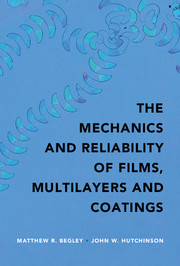Book contents
- Frontmatter
- Contents
- Acknowledgements
- Notation
- 1 Introduction
- 2 Key Mechanics Concepts
- 3 Linear Elastic Fracture Mechanics
- 4 Steady-State Delamination of Bilayers
- 5 Steady-State Delamination in Multilayers
- 6 Steady-State Channeling and Tunneling Cracks
- 7 Crack Kinking from an Interface
- 8 Crack Penetration, Deflection or Arrest?
- 9 Edge and Corner Interface Cracks
- 10 Buckling Delamination
- 11 Delamination of Thin Strips (Patterned Lines)
- 12 Delamination in Multilayers Subject to Steady-State Temperatures
- 13 Cracking under Transient Temperature Distributions
- 14 Software for Semi-Infinite Multilayers: Steady-State Delamination
- 15 Software for Semi-Infinite Multilayers: Transient Delamination
- 16 Finite Element Software for Multilayers: LayerSlayer FEA
- 17 Convergence and Benchmarks with LayerSlayer FEA
- Appendix Asymptotic Crack Tip Displacement Fields for an Interface Crack
- References
- Index
10 - Buckling Delamination
Published online by Cambridge University Press: 13 July 2017
- Frontmatter
- Contents
- Acknowledgements
- Notation
- 1 Introduction
- 2 Key Mechanics Concepts
- 3 Linear Elastic Fracture Mechanics
- 4 Steady-State Delamination of Bilayers
- 5 Steady-State Delamination in Multilayers
- 6 Steady-State Channeling and Tunneling Cracks
- 7 Crack Kinking from an Interface
- 8 Crack Penetration, Deflection or Arrest?
- 9 Edge and Corner Interface Cracks
- 10 Buckling Delamination
- 11 Delamination of Thin Strips (Patterned Lines)
- 12 Delamination in Multilayers Subject to Steady-State Temperatures
- 13 Cracking under Transient Temperature Distributions
- 14 Software for Semi-Infinite Multilayers: Steady-State Delamination
- 15 Software for Semi-Infinite Multilayers: Transient Delamination
- 16 Finite Element Software for Multilayers: LayerSlayer FEA
- 17 Convergence and Benchmarks with LayerSlayer FEA
- Appendix Asymptotic Crack Tip Displacement Fields for an Interface Crack
- References
- Index
Summary
For some multilayer systems that experience compression, buckling of the film in an initially debonded region may release energy that becomes available to drive the interface crack and increase the size of the debonded region. This phenomenon, called buckling delamination, occurs in structural composites where a compressed surface layer has debonded from its adjacent layers and buckles when the applied compression is sufficiently large. This surface layer may then delaminate if the interface toughness is not large enough to keep the interface crack from propagating. Buckling delamination is one of the most widely observed failure mechanisms in thin films and coatings on substrates when the stress is compressive. Buckling delamination involves the simultaneous interaction of buckling and interface cracking.
Two of the most commonly observed morphologies of buckling delaminations are seen in Figure 10.1. Both straight-sided and telephone cord delaminations have occurred in Figure 10.1(a) for a multilayered thin film deposited on a glass substrate where the film is subject to equi-biaxial compression. Straight-sided delaminations are rare under equi-biaxial compression. However, they are commonly observed when there is a dominant direction of compression in the film, in which case they propagate perpendicular to the direction of maximum compression. The telephone cord morphology is the mostly commonly observed morphology when the film is under equi-biaxial compression.
The buckle delamination in Figure 10.1(b) has formed under artificially constrained conditions created by patterning on the interface in a long narrowing wedge-shaped region of low adhesion before the film is deposited. The delamination, which takes place only within the low adhesion region, was initiated at the wide end and propagated towards the narrow edge, transitioning from the telephone cord morphology to the straight-sided morphology. Even when the film-substrate interface is not patterned, the delamination arrests along its sides and propagates at the curved front. Figure 10.2 shows a sequence of three closely spaced stages of the front propagation; the upper figures are a numerical solution discussed later, and the lower figures are the experimental observation.
This chapter develops the underlying mechanics of the buckling delamination with particular emphasis on the role of mixed-mode interface toughness, which is essential to understanding the existence, propagation and morphology of the various delamination modes.
- Type
- Chapter
- Information
- The Mechanics and Reliability of Films, Multilayers and Coatings , pp. 137 - 154Publisher: Cambridge University PressPrint publication year: 2017

